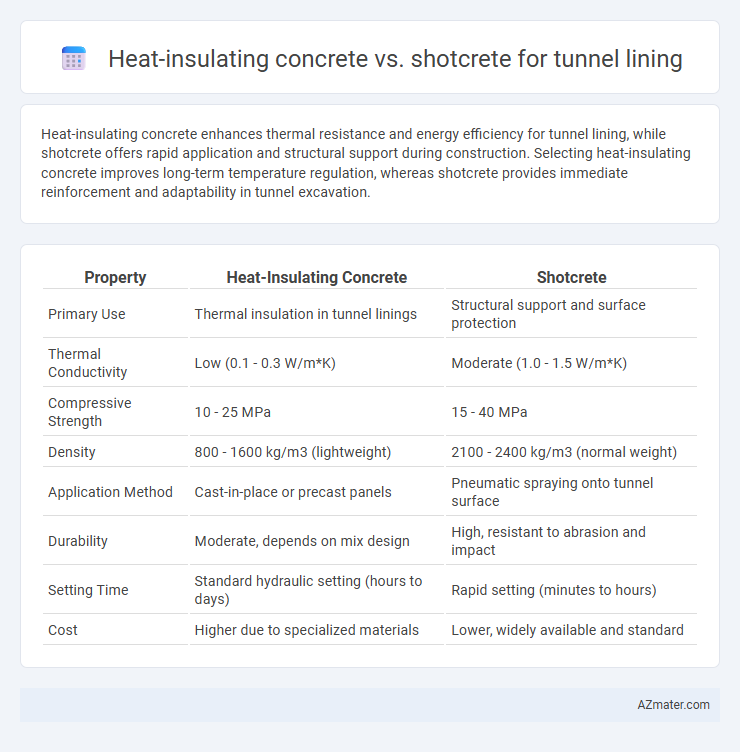Heat-insulating concrete enhances thermal resistance and energy efficiency for tunnel lining, while shotcrete offers rapid application and structural support during construction. Selecting heat-insulating concrete improves long-term temperature regulation, whereas shotcrete provides immediate reinforcement and adaptability in tunnel excavation.
Table of Comparison
| Property | Heat-Insulating Concrete | Shotcrete |
|---|---|---|
| Primary Use | Thermal insulation in tunnel linings | Structural support and surface protection |
| Thermal Conductivity | Low (0.1 - 0.3 W/m*K) | Moderate (1.0 - 1.5 W/m*K) |
| Compressive Strength | 10 - 25 MPa | 15 - 40 MPa |
| Density | 800 - 1600 kg/m3 (lightweight) | 2100 - 2400 kg/m3 (normal weight) |
| Application Method | Cast-in-place or precast panels | Pneumatic spraying onto tunnel surface |
| Durability | Moderate, depends on mix design | High, resistant to abrasion and impact |
| Setting Time | Standard hydraulic setting (hours to days) | Rapid setting (minutes to hours) |
| Cost | Higher due to specialized materials | Lower, widely available and standard |
Introduction to Tunnel Lining Materials
Heat-insulating concrete offers superior thermal resistance and energy efficiency compared to shotcrete, making it ideal for tunnels requiring enhanced temperature control. Shotcrete provides quick application and strong adhesion to irregular surfaces, widely valued for its structural support during tunnel construction. Selecting between heat-insulating concrete and shotcrete depends on thermal performance needs and construction timelines in tunnel lining projects.
Overview of Heat-Insulating Concrete
Heat-insulating concrete used in tunnel lining offers superior thermal resistance due to its composition with lightweight aggregates and insulating additives, reducing heat transfer and enhancing energy efficiency in underground environments. This material provides durability, fire resistance, and soundproofing properties, making it ideal for maintaining stable tunnel temperatures and protecting structural integrity. Compared to shotcrete, heat-insulating concrete delivers a more uniform thermal barrier, though it may require longer curing times and specific mix designs to optimize insulation performance.
Fundamentals of Shotcrete in Tunnel Construction
Shotcrete is a pneumatically applied concrete mix widely used in tunnel lining for its excellent adhesion and quick setting properties, allowing for efficient stabilization of excavated surfaces. Unlike heat-insulating concrete, shotcrete does not primarily provide thermal insulation but offers superior structural support and adaptability in irregular tunnel geometries. Its fundamental role in tunnel construction includes rapid application, improved bonding to rock surfaces, and the ability to incorporate reinforcing fibers for enhanced durability and load-bearing capacity.
Thermal Performance Comparison
Heat-insulating concrete offers superior thermal resistance with a lower thermal conductivity typically ranging between 0.1 to 0.3 W/m*K, effectively reducing heat transfer in tunnel linings. Shotcrete, while providing excellent mechanical strength and rapid application, generally exhibits higher thermal conductivity around 1.0 to 1.5 W/m*K, resulting in less effective thermal insulation. Therefore, heat-insulating concrete is preferred in tunnels requiring enhanced temperature regulation and energy efficiency.
Structural Strength and Durability
Heat-insulating concrete offers superior thermal resistance while maintaining high compressive strength, making it ideal for preventing heat transfer in tunnel lining without compromising structural integrity. Shotcrete provides excellent adhesion and rapid setting properties, ensuring durable and flexible application that conforms closely to tunnel geometries and withstands mechanical stresses. Combining shotcrete's versatility with heat-insulating additives can enhance both the durability and heat management of tunnel lining systems, optimizing long-term performance under harsh underground conditions.
Installation Process and Application Techniques
Heat-insulating concrete offers ease of installation through conventional formwork methods and can be sprayed or cast, providing uniform thermal resistance critical for tunnel lining. Shotcrete, applied via high-pressure spraying equipment, enables rapid placement and excellent adhesion to complex tunnel geometries, reducing construction time and minimizing formwork requirements. The choice between heat-insulating concrete and shotcrete hinges on project-specific factors like thermal performance needs, surface complexity, and installation speed.
Cost Analysis and Economic Factors
Heat-insulating concrete offers long-term energy savings by reducing thermal losses in tunnel lining, which translates to lower operational costs over the tunnel's lifespan. Shotcrete, while initially more cost-effective due to faster application and reduced labor, may incur higher maintenance expenses if thermal insulation performance diminishes. Evaluating total lifecycle costs, including installation, maintenance, and energy efficiency, reveals that heat-insulating concrete can provide better economic value for tunnels requiring enhanced thermal regulation.
Long-Term Maintenance and Lifecycle
Heat-insulating concrete offers superior thermal resistance, reducing temperature fluctuations and minimizing stress on tunnel linings, which contributes to extended durability and less frequent maintenance over its lifecycle. Shotcrete provides excellent adhesion and rapid application, but its long-term performance may be compromised by potential shrinkage and cracking, necessitating more regular inspections and repairs. Selecting heat-insulating concrete enhances lifecycle costs by lowering maintenance demands and improving structural resilience in tunnel environments.
Environmental Impact and Sustainability
Heat-insulating concrete reduces energy consumption by improving thermal efficiency and lowering ventilation demands in tunnels, thereby decreasing carbon emissions over the tunnel's lifespan. Shotcrete, while offering rapid application and structural strength, often requires frequent repairs due to lower thermal performance, potentially increasing maintenance-related environmental impacts. Incorporating heat-insulating materials within concrete formulations enhances sustainability by minimizing the tunnel's carbon footprint and extending service life compared to traditional shotcrete linings.
Choosing the Optimal Solution for Specific Tunnel Projects
Heat-insulating concrete provides superior thermal resistance and energy efficiency, making it ideal for tunnels in extreme temperature environments or where thermal stability is crucial. Shotcrete offers enhanced adaptability and rapid application suited for complex tunnel geometries and quick structural reinforcement, especially in variable ground conditions. Selecting the optimal solution depends on project-specific factors such as thermal requirements, tunnel design complexity, construction speed, and local geological conditions.

Infographic: Heat-insulating concrete vs Shotcrete for Tunnel lining
 azmater.com
azmater.com